Food Service Planning: Key Strategies and Effective Solutions
Updated On: October 23, 2025 by Aaron Connolly
Understanding Food Service Planning
Food service planning means coming up with practical strategies for how restaurants and food operations actually run each day. You have to think about everything—buying ingredients, prepping, serving customers, and making sure every step fits together.
Core Principles of Planning
Start by seeing your operation as one big connected system. Every decision ripples out and affects everything else.
You build your operation on the procurement process. You need suppliers you can count on for fresh, quality ingredients delivered when you need them. If they drop the ball, your kitchen grinds to a halt.
You have to keep ingredients fresh and safe with good storage systems. That means getting temperatures right, rotating stock, and tracking inventory. Mess this up, and you’ll have food waste or, worse, safety issues.
Your kitchen workflow decides how fast you can get plates out. The layout should let your team move quickly without running into each other. Where you put equipment matters, sometimes even more than the equipment itself.
Menu design ties directly to what your kitchen can handle. If you want to offer complicated dishes, you’ll need skilled staff and the right gear. For new places, simpler menus usually work out better.
Staff training keeps things consistent. Everyone on the team should know the basics—food safety, prep steps, and how to treat customers.
Objectives and Benefits
The big goal here? Build a profitable operation that serves good food, every time. Solid planning helps you dodge problems before they even show up.
Planning makes cost control way easier. You can track what you spend on ingredients, cut down on waste, and keep portions in check. A lot of restaurants go under because they don’t get a handle on their costs.
When everything runs smoothly, customers notice. Fast service, food that tastes the same every visit, and clean spaces—those are the things that keep people coming back.
Clear procedures help staff work better together. When everyone knows their job, there’s less confusion during busy times. That usually means happier staff and less turnover, too.
You can also manage risks better if you plan ahead. Following food safety rules and prepping for equipment failures or supply hiccups saves you from big headaches.
Good planning even opens the door for growth. You can spot what customers want and tweak your menu to match.
Key Stakeholders
Lots of people have a stake in food service planning, and each group cares about different things.
Management teams make the big calls—menus, budgets, operations. They need solid data and a real understanding of both what customers want and what things cost.
Kitchen staff bring the plans to life. Chefs and cooks need clear recipes, the right tools, and enough time. Their feedback often leads to better planning.
Service staff face customers every day. Servers and cashiers need to know the menu and can share what customers are saying.
Suppliers bring in the ingredients and equipment. Building good relationships with them keeps your quality and pricing steady. Many places team up with local suppliers for this reason.
Customers decide whether you succeed or not. Their preferences, diets, and spending habits shape all your decisions. You should listen to their feedback and adjust as needed.
Health inspectors and regulators set the safety standards. You have to plan for compliance with health codes and food safety laws.
Assessing Operational Needs
Before you open any food service operation, you need to figure out what your kitchen can actually do and what level of service you want to offer. These two steps lay the groundwork for your business plan.
Evaluating Service Requirements
You start by deciding who your customers are and how you want to serve them. A quick sandwich shop and a fancy sit-down place need totally different setups.
Key service factors to think about:
- Customer volume – How many people do you expect each day?
- Service speed – Is it table service or counter service?
- Menu complexity – Are you keeping it simple or going all out?
- Peak hours – Can your kitchen keep up when it gets busy?
Your goals have to match your real capabilities. If you want to serve 200 lunches but the kitchen can only handle 100 meals an hour, you’ve got a problem.
Staffing needs matter, too. For fine dining, you might have one server for every four tables. In casual spots, it’s often one for every eight.
Service assessment checklist:
- Who’s your target customer, and how much do they spend?
- What’s the average ticket size?
- How fast do you need to serve (orders per hour)?
- Can your kitchen output match your seating?
- What staff-to-customer ratios make sense?
Conducting Kitchen Audits
A kitchen audit means looking at every piece of equipment, your workflow, and storage areas. You want to spot bottlenecks before they slow you down.
Check your equipment first. Can your grill handle the rush? Do you have enough fridge space for daily deliveries?
Audit essentials:
- Equipment: Is it in good shape? Can it keep up?
- Food storage and cold chain: Are you keeping things at the right temp?
- Workflow: Can staff move easily?
- Health and safety: Are you following the rules?
- Utilities: Do you have enough gas, electric, and water?
Walk through your prep steps one by one. Time how long each dish takes from order to plate. Look for spots where things slow down.
Check your storage ratios. Most places use 20-30% of their space for dry storage and keep enough cold storage for three to five days of inventory.
Cleaning and maintenance schedules matter, too. If something breaks during service, it can shut you down.
Take photos and measurements as you go. This audit helps you plan equipment upgrades, staff training, and new procedures.
Menu Planning and Development
Great menu planning means knowing your customers and making smart business choices. You want dishes people actually want, consistent quality, and prices that make sense for your market.
Aligning Offerings with Customer Preferences
You can’t plan a menu in a vacuum. Start by figuring out what people in your area actually like to eat, what diets they follow, and how much they’ll spend.
How to learn about your customers:
Survey your current guests, check out sales data from similar places, and look at local demographics. Social media and review sites can be surprisingly helpful—they show what’s working and what isn’t.
Your menu should offer variety without overwhelming people. Most successful spots stick to 8-12 main dishes, covering different diets. Don’t forget vegetarian options and be mindful of allergies.
Pricing has to fit your area. Family restaurants and fine dining charge very differently. Try new dishes as specials first to see if people bite.
Standardising Recipes and Portions
Consistency keeps people coming back—and helps you control costs. You want recipes that anyone in your kitchen can follow, no matter who’s cooking.
Write down every recipe with exact measurements, cooking times, and plating instructions. Spell out every step, from prep to garnish. This keeps things the same, even when staff changes.
Portion control matters for your bottom line. Weigh and measure servings, and use the same tools every time. That way, you don’t lose money by giving away too much food.
Train staff on your standards. New cooks need hands-on practice with each recipe. Regular meetings help you catch issues before they turn into customer complaints.
When you standardise recipes, cost calculations get way easier. You know exactly what each dish costs, so you can price menus and track waste.
Menu Engineering Techniques
Menu engineering is basically using data to tweak your menu for better profits. You look at sales and margins, then adjust what you feature.
Break your menu into four types: Stars (popular and profitable), Plowhorses (popular but low profit), Puzzles (profitable but not big sellers), and Dogs (neither popular nor profitable).
Where you place items on the menu matters. Put high-profit dishes where people’s eyes naturally go first. Use boxes, bold text, or photos to highlight what you want to sell.
Pricing tricks help, too. Skip the currency signs, use prices like £9.95 instead of £10, and offer three price points for similar items to nudge people towards the middle.
Keep checking your sales data. See what’s selling, what isn’t, and make changes as you go. Track food costs, prep time, and listen to customer feedback.
Facility and Layout Design
Getting your facility design right from the beginning saves money and a lot of stress down the line. Good space planning and smart equipment choices make everything run smoother.
Space Allocation and Workflow
Food moves through your place in a set order—from delivery, to storage, to prep, to cooking, to service. Your design should follow this flow, so you don’t create bottlenecks or safety issues.
Start with receiving and storage near where deliveries come in. Then, ingredients move to prep, then to cooking, and finally out to service. Each area should connect logically.
Give yourself more storage space than you think you’ll need—at least 20% extra. Equipment fails sometimes, and extra inventory can save the day.
Prep areas need good ventilation and easy access to sinks. Keep raw and cooked food separate to avoid cross-contamination. Cold prep works best away from hot equipment.
Your kitchen’s layout depends on your menu. Straight-line designs work for simple menus. If things get more complex, try zones where similar tasks happen together.
Think about how staff move. Wide aisles help during rushes. Put handwashing sinks where people will actually use them—not hidden away.
Selecting Equipment and Technology
Pick equipment based on what your menu actually needs. Oversized gear wastes space and energy. If it’s too small, you’ll get bottlenecks.
Go for commercial-grade equipment—it costs more upfront but lasts longer. Look for Energy Star labels to save on utilities. Gas stoves usually give better heat control, but electric is great for prep.
Plan your utilities early. Adding more gas or electric later gets expensive fast. If you might expand, leave room for extra equipment.
Tech matters, too. You need point-of-sale systems, inventory software, and kitchen screens. Make sure you’ve got solid internet and backup power. Place screens where staff can see them easily.
Ventilation keeps the kitchen comfortable and safe. If it’s too small, the kitchen gets hot and smoky. Work with pros to size it correctly for your equipment.
Where you put refrigeration matters for both workflow and energy bills. Keep cold storage close to prep areas and away from heat sources.
Operational Cost Management
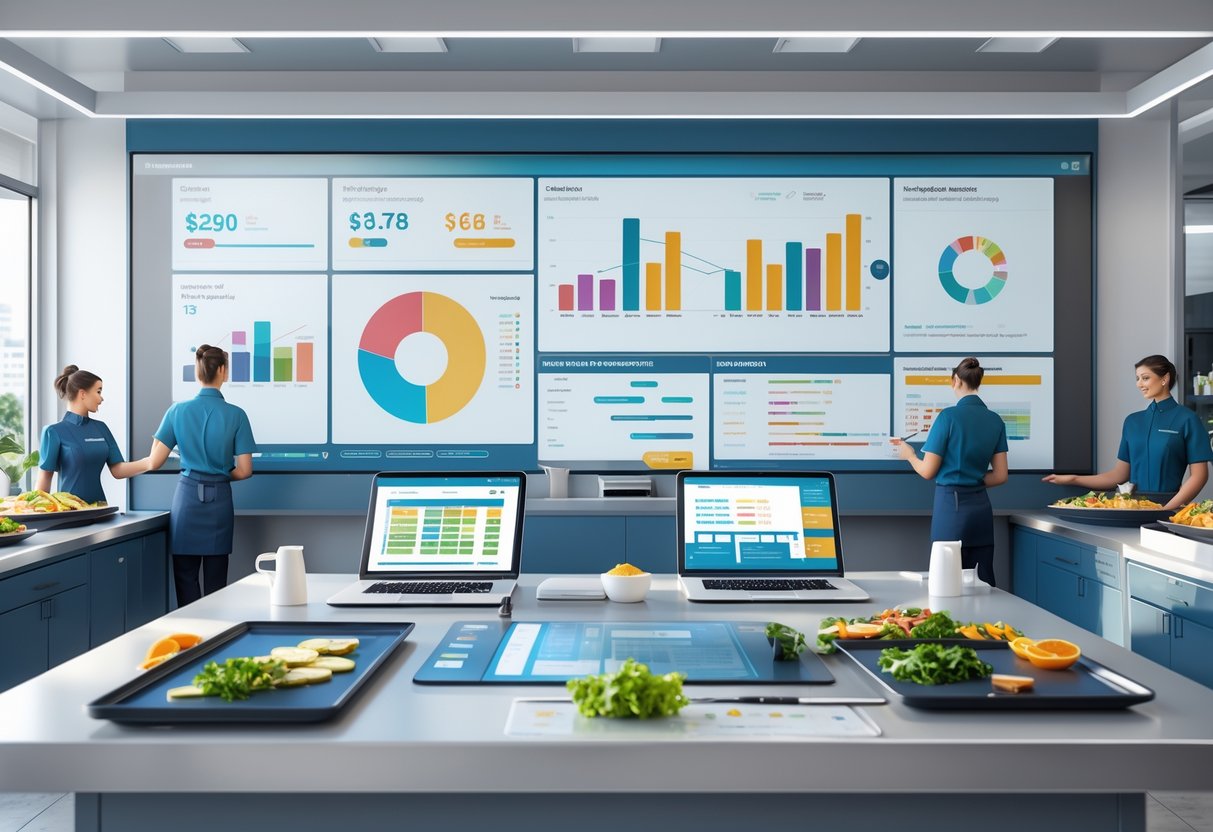
Managing costs really comes down to setting a clear budget and keeping an eye on expenses. If you want to protect your profit margins and keep your food standards up, you have to stay on top of both.
Budgeting Strategies
Start by breaking your costs into categories: food and drinks, staff, utilities, equipment, and supplies.
Food costs usually take up 28-35% of your revenue. Labour is often 25-35%. Check these numbers each month to spot trends.
Budget categories to track:
- Ingredients and inventory
- Wages and benefits
- Energy and utilities
- Equipment maintenance
- Cleaning supplies and disposables
Set aside 2-3% of revenue for surprise repairs. That way, emergencies don’t wreck your cash flow.
Look over your budget every quarter and compare it to what you’re actually spending. Ingredient prices change, so you’ll need to adjust. Leave some wiggle room for seasonal swings.
Monitoring Expenses
Tracking expenses every day helps catch small overruns before they snowball into bigger issues. Modern point-of-sale systems now calculate food costs per dish sold, so managers can see costs in real time.
Each week, we check key performance indicators. Food cost percentage, labour cost per hour, and waste levels all show early warning signs if something’s off.
Critical metrics to monitor:
- Daily food waste amounts
- Ingredient usage vs sales ratios
- Staff productivity levels
- Energy consumption patterns
- Supplier invoice accuracy
Weekly inventory counts show if actual usage matches what we expect. If the difference goes above 2-3%, we probably have portion control issues or even theft.
Auditing invoices helps us spot billing mistakes and unauthorised price hikes. Always check delivery receipts against invoices right away. Suppliers sometimes overcharge or list items they never delivered—usually by accident, but still.
Digital dashboards display daily costs, letting managers tweak schedules or orders quickly. If labour costs jump over budget, we can adjust shifts on the spot to avoid missing weekly targets.
Sustainability and Waste Management
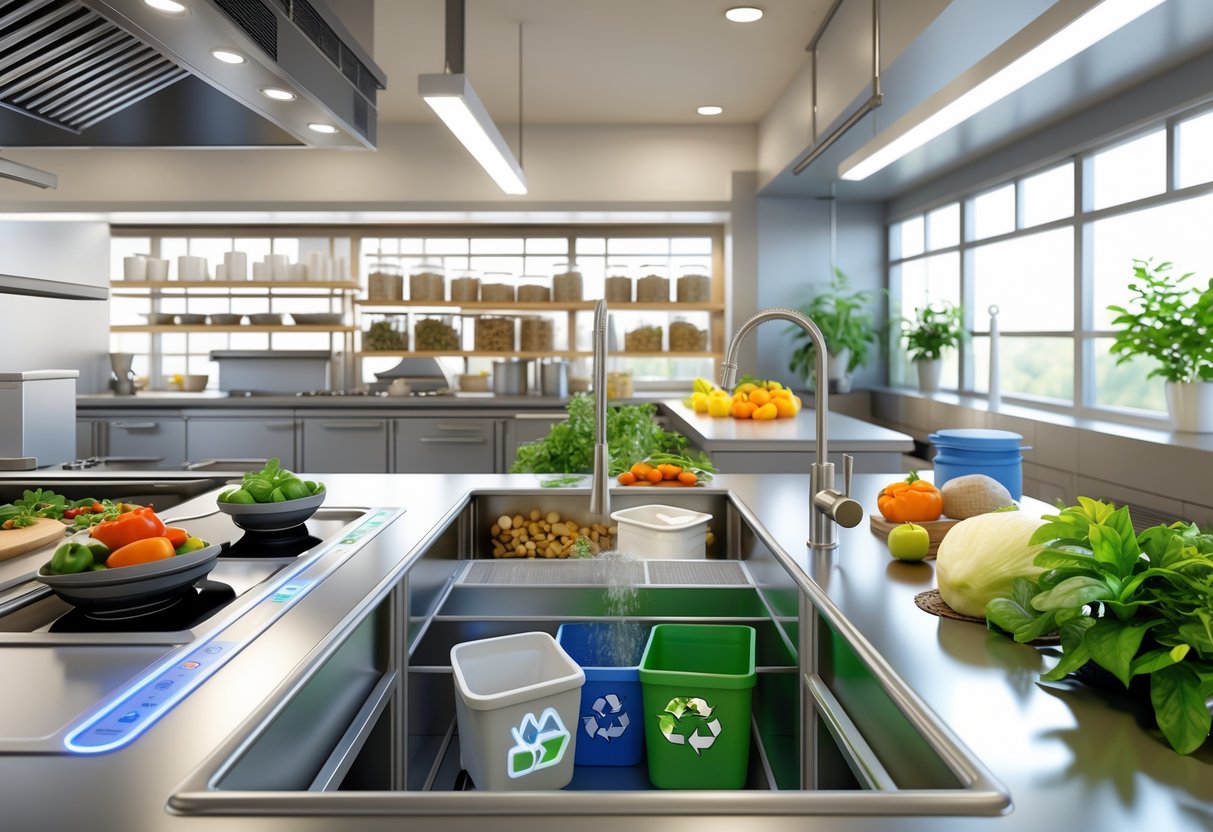
Food service operations create a lot of waste, so we have to plan carefully. Smart waste reduction strategies, responsible sourcing, and good disposal habits all make a real difference for the environment and our bottom line.
Minimising Food Waste
Food waste makes up the biggest chunk of restaurant waste—somewhere between 44% and 60%. Cutting this down takes planning and constant monitoring at every step.
Menu Planning and Portion Control
We design menus that use ingredients in multiple dishes, which helps keep spoilage low. Getting portion sizes right also stops plate waste and keeps customers happy.
Inventory Management
Using a first-in, first-out (FIFO) system makes sure older ingredients get used first. Digital inventory tracking predicts what we’ll need and stops us from over-ordering.
Staff Training
Teaching staff proper food handling and storage keeps ingredients fresh longer. They also need to know how to tell if food is actually spoiled or still good.
Donation Programs
Linking up with local food banks lets us donate surplus food instead of throwing it away. Many places even have collection services to make this easy.
Sustainable Sourcing
Sustainable sourcing cuts our environmental impact and often boosts food quality. It also supports local economies if we do it right.
Local and Seasonal Purchasing
Buying from nearby suppliers cuts down on transport emissions. Seasonal menus work with what’s naturally available and usually save money too.
Certification Standards
We look for suppliers with certifications like Organic, Fair Trade, or Marine Stewardship Council. These labels show they use responsible practices.
Supplier Partnerships
Building strong relationships with sustainable suppliers creates stability. We can work together to cut packaging waste and streamline deliveries.
Plant-Forward Options
Adding more vegetarian and vegan dishes lowers our environmental impact. Plant-based proteins use fewer resources than meat and dairy.
Waste Disposal Methods
Proper waste disposal means sorting materials so they get processed the right way. Just tossing everything in landfill isn’t good enough.
Organic Waste Processing
Composting turns food scraps into useful soil. If we don’t have space, commercial composting services can handle it.
Recycling Programs
We separate glass, cardboard, and metals for recycling. Most waste companies will provide bins for each type.
Oil and Grease Management
Used cooking oil needs special handling but can become biodiesel. Licensed waste oil collectors sometimes even pay for large amounts.
Packaging Reduction
We ask suppliers for minimal, recyclable packaging. Buying in bulk also cuts down on packaging waste.
Maximising Profitability
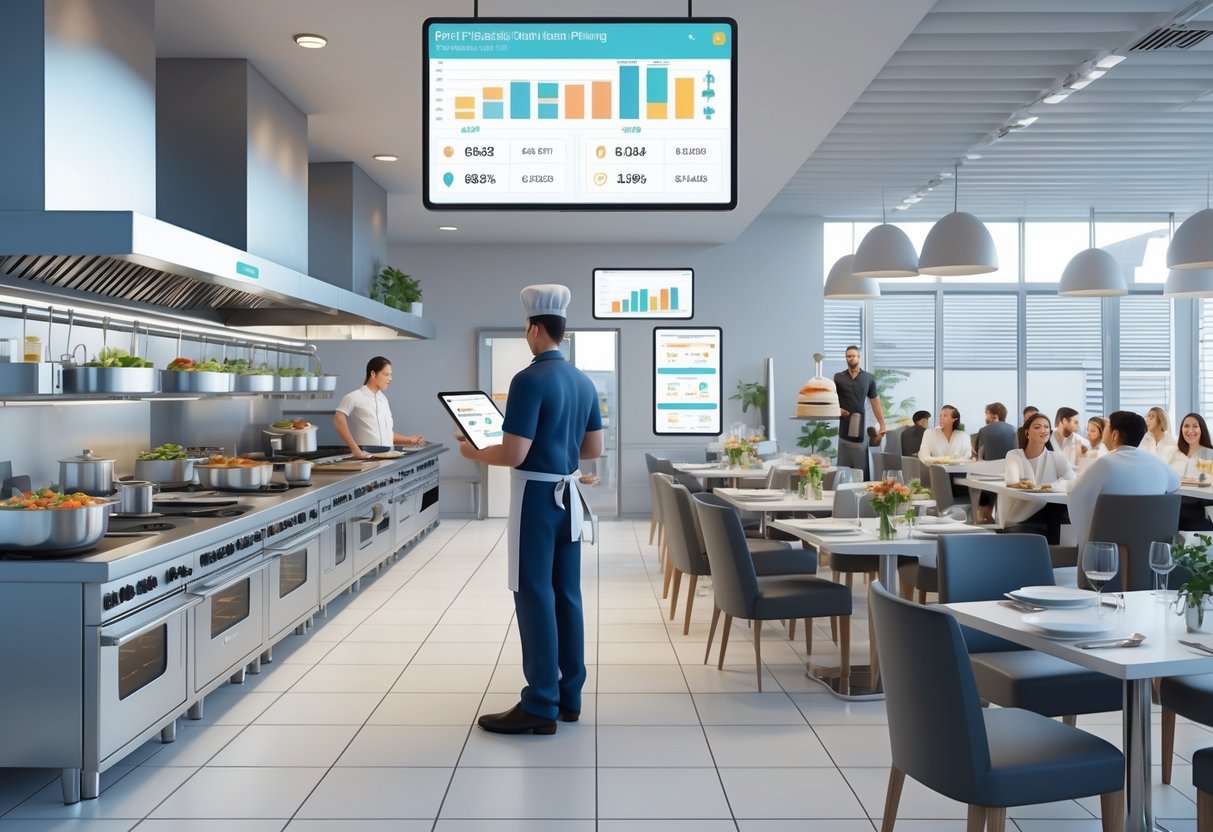
Boosting profitability comes down to smart pricing and tight margin management. With the right tactics, even struggling operations can turn things around.
Pricing Strategies
Dynamic pricing lets us earn more during peak times and fill seats when it’s slow. We can tweak prices based on demand, time, or special events.
Peak Period Pricing:
- Raise prices 10-15% on weekends and holidays
- Set premium rates for big days like Valentine’s or Mother’s Day
- Use digital menu boards to change prices instantly
Off-Peak Incentives:
- Offer 20-30% discounts for early birds before 6 PM
- Run “Happy Hour” food specials to draw afternoon crowds
- Target weekday lunches with value deals
Menu engineering helps us highlight high-margin items. We analyse what sells and what makes money, then place those dishes where customers notice them.
Quick Win: Put your most profitable dishes in the top-right corner of the menu—that’s where people look first.
Margin Optimisation
Food costs usually eat up 28-35% of revenue, so we have to manage ingredients closely. We avoid waste and over-ordering by tracking inventory daily.
Cost Control Measures:
- Do daily inventory checks to avoid buying too much
- Train staff to serve the right portions every time
- Use seasonal ingredients to keep costs down
- Watch waste patterns and adjust prep amounts as needed
Labour costs should stay between 25-30% of revenue for full-service spots. Cross-training staff gives us flexibility and reduces overtime.
Labour Efficiency:
- Build schedules around sales history and even the weather
- Teach servers to handle hosting when it’s quiet
- Use scheduling software to match staff levels to demand
But let’s be real—cutting costs too much can hurt service and drive customers away.
High-margin add-ons like premium sides or drinks bump up average sales with little extra effort. These simple upsells usually have profit margins of 70-90%.
Implementing Surveys and Feedback Systems
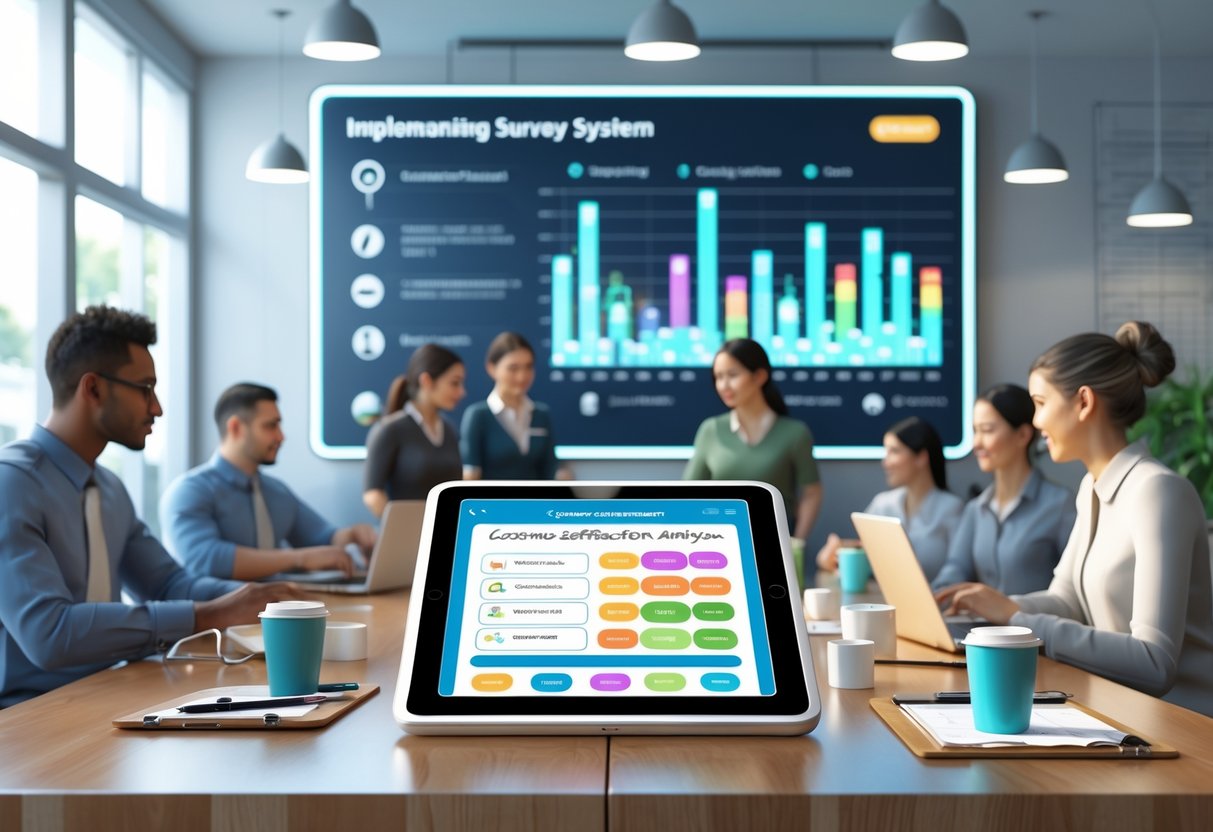
Collecting feedback regularly helps us spot what’s working and what needs fixing. The trick is to keep surveys simple and actually use the answers to make things better.
Guest Satisfaction Surveys
Surveys need to be quick—nobody wants to spend more than a couple of minutes. Digital surveys are best because customers can fill them out on their phones.
We can add QR codes to receipts or table tents that link straight to our survey.
The must-ask questions are:
- Overall satisfaction rating (1-10 scale)
- Food quality and temperature
- Service speed and friendliness
- Cleanliness of dining area
- Value for money
Keep questions short and to the point. Use a mix of rating scales and one or two open-ended questions like “What could we improve?” That way, we get both measurable data and real suggestions.
Offer surveys through different channels. Some guests prefer digital, others like old-school comment cards. Timing matters too—send follow-up emails within 24 hours, while the meal is still fresh in their mind.
Analysing Customer Feedback
Raw survey results don’t mean much unless we actually look for patterns. We need to spot recurring issues and act on them.
Look for recurring themes first. If several guests mention slow service or cold food, those go to the top of our fix-it list. Set up a simple tracking system to log common complaints every week.
| Issue Type | Frequency | Action Required |
|---|---|---|
| Slow service | 15 responses | Staff training |
| Cold food | 8 responses | Kitchen timing review |
| Dirty tables | 3 responses | Cleaning schedule update |
We should calculate satisfaction scores every month and look for trends. If the average drops from 8.2 to 7.6, something’s wrong and needs attention.
Closing the feedback loop matters too. Thank happy customers and reach out to unhappy ones if possible. Show we’re listening by making changes and telling both our team and customers about improvements.
Hold monthly meetings to review survey results with staff. Share both praise and areas for growth to keep everyone focused on customer satisfaction.
Staffing and Training
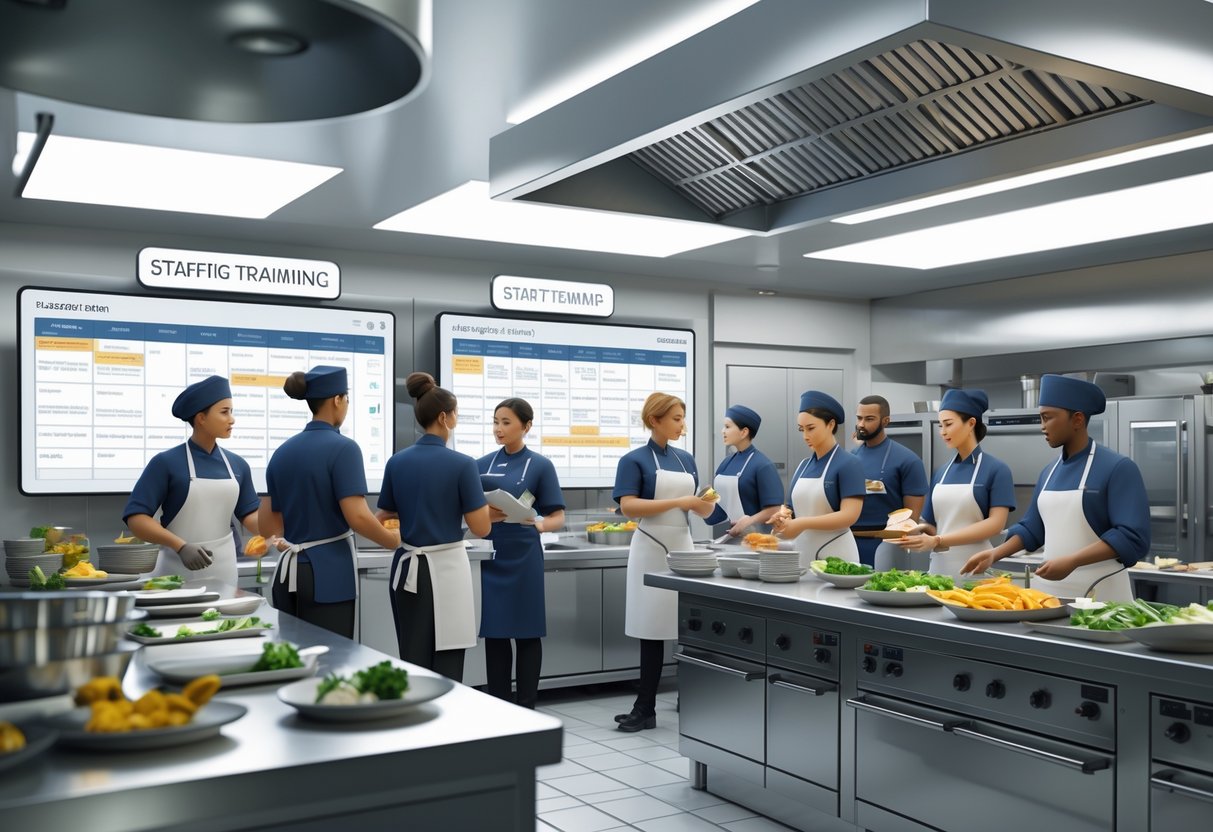
Good staff planning starts with clear roles and solid training. Both front-of-house and kitchen teams need the right skills to handle busy shifts and deliver consistent quality.
Defining Roles and Responsibilities
We need clear job descriptions so everyone knows what to do, especially during rushes.
Front-of-house roles include servers, hosts, and cashiers. Servers take orders, deliver food, and process payments. Hosts manage seating and wait times. Cashiers handle transactions and takeaway orders.
Back-of-house positions include cooks, prep staff, and dishwashers. Head cooks run the kitchen during service. Prep staff handle ingredient prep and stock rotation. Dishwashers keep everything clean.
Cross-training is a lifesaver when someone calls in sick. We train servers in basic food prep and cooks in customer service basics. That flexibility keeps things moving.
Each shift needs a clear list of tasks. Opening staff prep ingredients and check equipment. Closing staff clean up and lock down the place.
Employee Training Programmes
New hires need structured training before they’re on their own. A three-week programme works well for most places.
Week one covers food safety and the basics. Everyone learns handwashing, temperature checks, and allergen awareness. This is required by law and keeps customers safe.
Week two focuses on job-specific skills. Servers practice the till and order-taking. Kitchen staff learn recipes and cooking techniques. All staff go over emergency procedures.
Week three is all about supervised shifts. New team members serve real customers but get feedback right away. This builds confidence before they go solo.
Refresher training keeps standards high. Monthly sessions cover food safety updates and new menu items. Every quarter, we tackle feedback and service improvements.
Training costs usually run £200-400 per employee, including materials and trainer time. It’s money well spent because it cuts down on mistakes and staff turnover during busy times.
Safety and Compliance
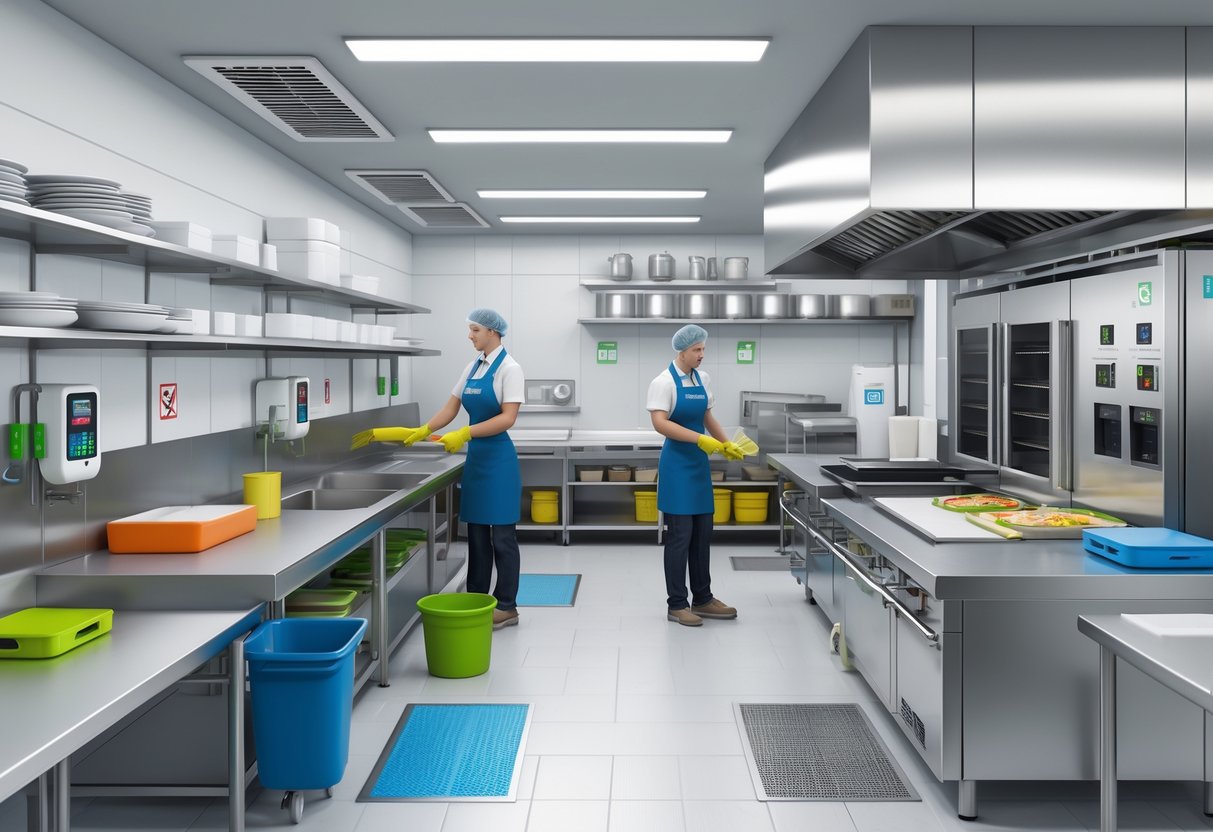
Food service teams have to follow strict safety rules to protect customers and avoid legal headaches. These rules cover everything from food storage temperatures to handwashing procedures.
Food Safety Standards
Food safety standards are there to keep customers healthy and businesses legal. The Food Standards Agency sets the rules, and we have to follow them.
Temperature control is the biggest deal. Hot food stays above 63°C during service. Cold food needs to be below 8°C.
Staff need proper training before they start. They must know safe food handling, storage, and cleaning procedures.
| Food Type | Safe Storage Temperature | Maximum Storage Time |
|---|---|---|
| Raw meat | 0-4°C | 3-5 days |
| Cooked rice | Above 63°C or below 4°C | 24 hours |
| Dairy products | Below 4°C | Use-by date |
| Fresh vegetables | 4-8°C | 5-7 days |
HACCP systems help us spot risks before they turn into real problems. We check critical points like cooking temperatures and storage.
Local authorities do regular inspections to make sure we comply. We have to keep good records of temperatures, cleaning, and staff training.
Health and Hygiene Protocols
Personal hygiene stops contamination and keeps food safe. Everyone on staff has to follow these rules, no exceptions.
Handwashing means using soap, warm water, and scrubbing for at least 20 seconds. Staff must wash up after using the toilet, handling raw foods, or touching surfaces.
Staff wear clean aprons, hair covers, and closed-toe shoes. If someone has a cut, they need a waterproof plaster and gloves.
Cleaning schedules cover all surfaces, equipment, and storage areas. We use approved sanitisers and follow the instructions for mixing them.
Sick staff can’t work with food. Anyone with vomiting, diarrhoea, or infected wounds stays home until they’re fully recovered.
Pest control includes regular checks, sealed storage, and professional treatments when needed. We document everything for inspection.
To stop cross-contamination, we use separate cutting boards for raw meat and veggies. All surfaces get cleaned and sanitised between tasks.
Project Management and Timelines
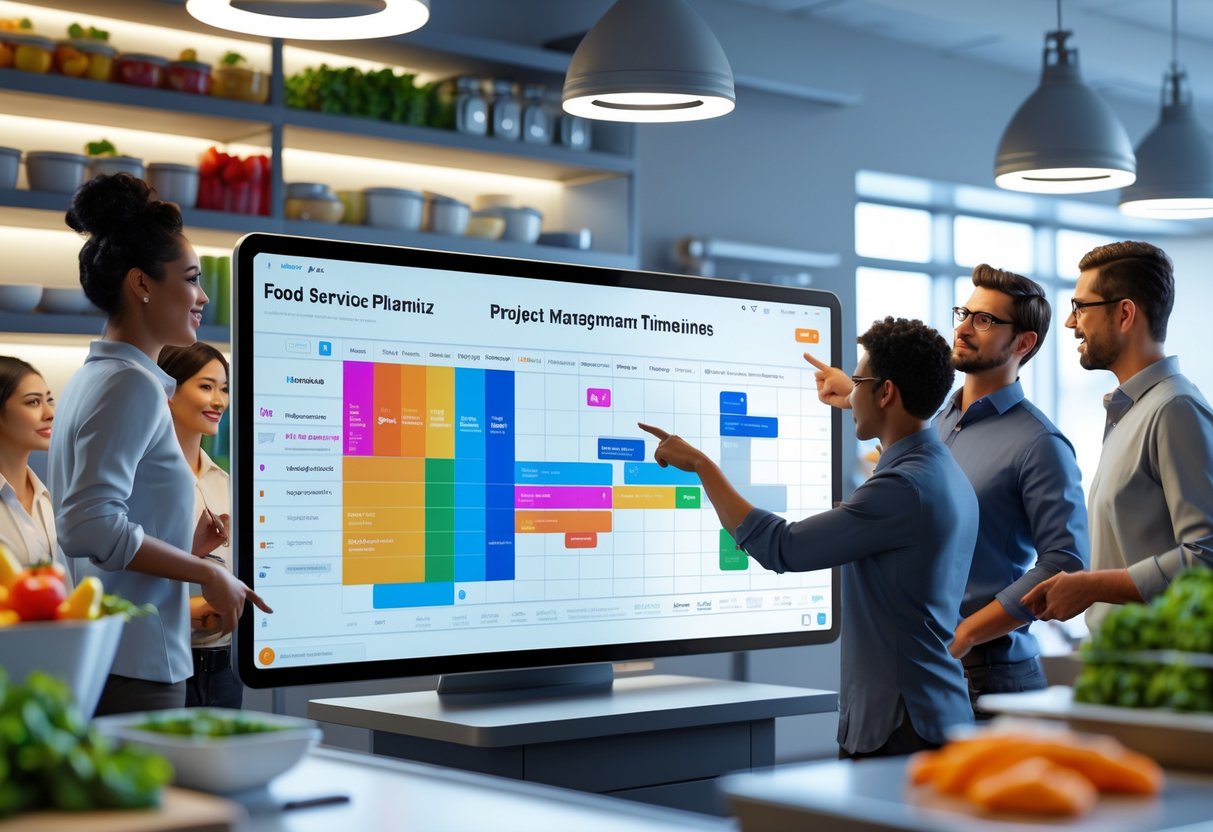
Good project management keeps food service planning on track and stops expensive delays. Setting clear milestones and working closely with vendors helps us build timelines that actually work.
Setting Milestones
We break food service projects into clear checkpoints that actually show progress. Each milestone needs a deadline and a deliverable you can measure.
Key milestone categories include:
- Menu finalisation and testing
- Equipment installation and testing
- Staff hiring and training completion
- Health department approvals
- Soft opening preparation
Start with your opening date and work backwards. Give yourself some buffer time between milestones.
Most food service projects need at least 20% extra time for unexpected issues.
Track progress every week using simple tools like spreadsheets or project apps.
Mark milestones as green, amber, or red based on their status. This makes it easier to spot problems before they get out of hand.
Write down what causes delays at each milestone. Equipment delivery problems, permit delays, and staff scheduling conflicts come up a lot.
Coordinating with Vendors
Vendor coordination really comes down to clear communication and solid deadlines from the beginning. We always set up a main contact for each vendor and stick to regular check-ins.
Create a vendor timeline that includes:
| Vendor Type | Lead Time Needed | Key Deadlines |
|---|---|---|
| Equipment suppliers | 4-8 weeks | Order, delivery, installation |
| Food suppliers | 2-4 weeks | Menu approval, first delivery |
| Contractors | 6-12 weeks | Plans, permits, completion |
Send weekly updates to all vendors. If anything changes in the schedule or requirements, let them know right away.
Late changes eat up time and money.
Add penalty clauses to vendor contracts for missed deadlines. When possible, offer incentives for early completion.
Always have backup vendors ready for critical items.
Keep detailed records of every vendor conversation. Use email to confirm what you agreed to and to track deliveries.
Evaluating Performance and Continuous Improvement

Tracking how your food service operation performs—and making regular improvements—keeps your business competitive and profitable. We need to pick the right data points and actually use them to make smart changes.
Measuring Key Performance Indicators
Food service operations need specific metrics to see if they’re working. We should track these essential performance indicators weekly and monthly.
Financial metrics show us if we’re making money and controlling costs. Food cost percentage should stay between 28-35% for most restaurants.
Labour costs usually run 25-30% of total sales.
Operational metrics tell us how smoothly we run the place. Table turnover rates, average order times, and customer wait times all affect revenue.
A busy restaurant should turn tables 2-3 times per service.
Quality indicators measure customer satisfaction and food safety. We can track complaint rates, food safety audit scores, and return customer numbers.
Online review scores give us real-time feedback about service quality.
Key metrics to monitor:
- Daily food waste percentages
- Average order value per customer
- Staff productivity rates
- Energy and utility costs
- Inventory turnover ratios
Digital point-of-sale systems make tracking all this way easier.
Most modern systems generate automatic reports to show trends.
Adapting Plans for Future Success
Performance data helps us make better decisions about menus, staffing, and operations. We should review our numbers every month and adjust our plans when needed.
Menu optimisation means looking at which dishes actually sell and make money. If an item has high food costs or barely sells, it’s time to swap it out or tweak the recipe.
Seasonal changes keep menus interesting and costs in check.
Staff scheduling gets easier when we know our busy and slow times. Sales data shows us exactly when to add or cut shifts.
This cuts labour costs but keeps service quality up.
Supplier relationships work best with regular reviews. We should check delivery times, product quality, and pricing from each vendor every quarter.
A poor supplier costs us money and reputation.
Process improvements come from finding bottlenecks and waste. Kitchen workflow analysis might show we need new equipment or a layout change.
Watching the front-of-house can reveal ways to make service smoother.
Regular team meetings let us talk through performance metrics and new ideas.
Staff often see problems and solutions that management misses.
We should set up simple feedback systems so everyone can suggest improvements.
Frequently Asked Questions
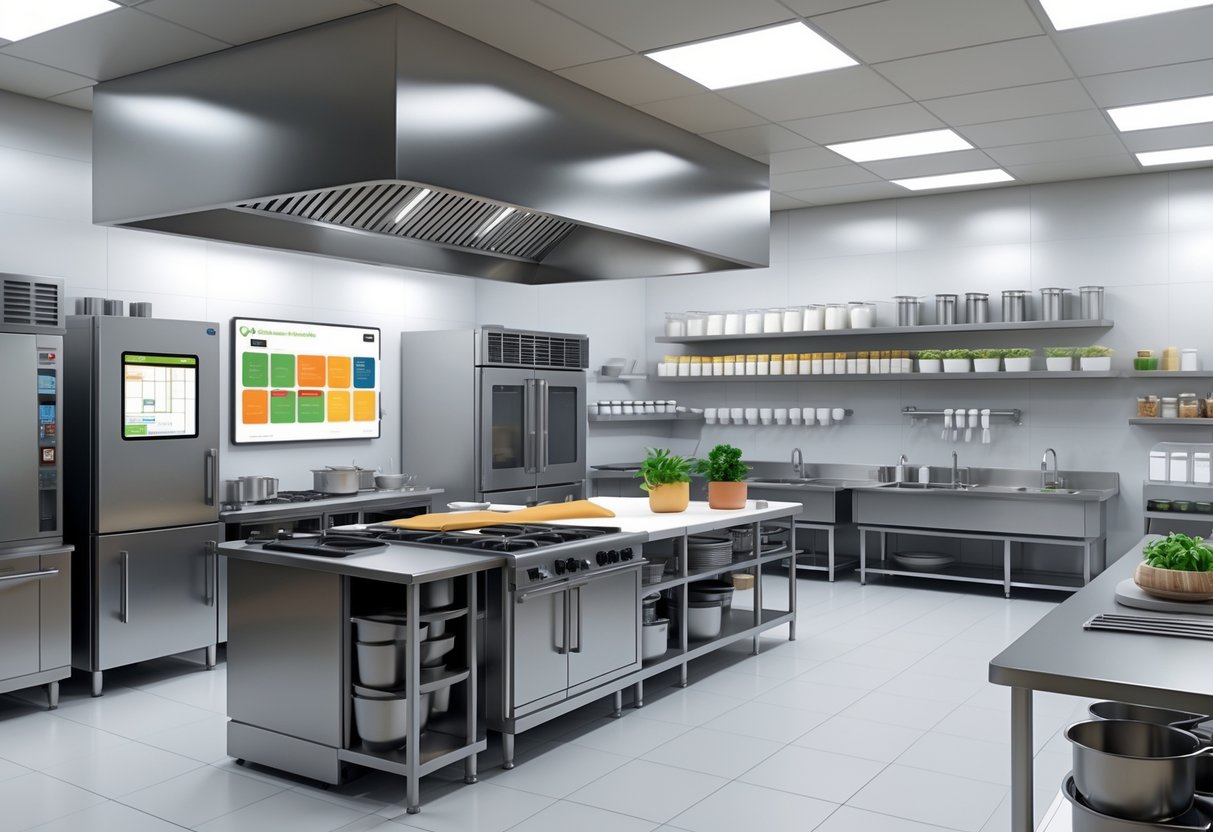
Getting permits and licences for food service can feel overwhelming. Every operation has its own requirements.
These questions cover the most common permit applications—from temporary events to food trucks and permanent restaurants.
How do I apply for a temporary food service permit?
Contact your local health department at least 10-14 days before your event. Most councils need this notice to process your application.
Fill out the temporary food service application form. You’ll need to provide your event dates, location, and what food you’ll serve.
Attach your menu to the application. List all food items, how you’ll prepare them, and where you’ll store ingredients safely.
Submit proof of food safety training for at least one person at the event. Most areas want to see a valid food handler’s certificate or something similar.
Pay the application fee when you turn in your forms. Temporary permit fees usually range from £50-150, depending on your location and event size.
What are the requirements for obtaining a mobile food service licence?
First, check if mobile food units are allowed where you plan to operate. Some cities and counties don’t allow food trucks, so double-check with your local office.
You’ll need a base of operation or a commissary kitchen—a licenced commercial kitchen where you can prep food, clean equipment, and store supplies.
Your mobile unit must have the right equipment for safe food handling. That means hand washing stations, refrigeration, cooking equipment, and waste water storage.
Apply through your local health department with detailed plans for your mobile unit. Include equipment specs, menu items, and your commissary agreement.
Schedule an inspection for both your mobile unit and commissary kitchen. You can’t start operating until both locations pass inspection.
Could you guide me through the process of a food plan review with the local council?
Start by filling out a plan review application with your local health department. This is always the first step before opening any food service business.
Send in detailed floor plans showing your kitchen layout, equipment placement, and workflow. Make sure to include specs for ventilation, plumbing, and electrical systems.
Your plans need to show separation between raw and cooked food areas. Add details about hand washing stations, storage, and customer seating if you have it.
The review process usually takes 2-4 weeks, but complex projects or custom equipment can take longer.
You’ll get feedback with any required changes. Make those adjustments and resubmit before you book your pre-opening inspection.
What documents are necessary for a food service permit application?
You’ll need completed application forms for your specific type of food service. Download them from your health department’s website or pick them up in person.
Provide detailed, to-scale floor plans showing equipment placement and workflow. If you have a dining area, include a separate plan for that.
Add your proposed menu with prep methods for each item. Explain how you’ll store, cook, and serve different foods safely.
Attach food safety training certificates for key staff. Most places require at least one certified food handler or manager on duty during operating hours.
Include your business licence and any needed zoning approvals. Some locations also require permits for outdoor seating, alcohol, or entertainment.
Can you tell me how to secure a food permit from the health department?
Reach out to your local health department to find out which type of permit you need. The requirements are different for restaurants, catering, food trucks, and temporary events.
Fill out the application with accurate information about your operation. Include your menu, equipment, staff training, and operating hours.
Send in all required documents: floor plans, equipment specs, and food safety certificates. Missing paperwork will slow things down.
Pay the permit fee when you submit your application. Fees vary but usually range from £200-800 for permanent businesses.
Book your pre-opening inspection after your application gets approved. You need to pass this inspection before you can legally serve food.
What steps should I take to successfully apply for a food business licence?
First, register your business name and structure with Companies House if you’re in the UK. You’ll need these documents later for your food service applications.
Next, reach out to your local authority’s food safety team and register your food business. The law says you have to do this at least 28 days before you start trading.
Make sure you and any key staff complete food hygiene training. Most food handlers need at least a Level 2 Food Safety and Hygiene certification.
Set up your food safety management system using HACCP principles. This helps you show exactly how you’ll spot and control food safety risks in your business.
If you plan to sell alcohol or operate late at night, you’ll need extra licences. Each of these comes with its own application process and fees, separate from your basic food licence.

